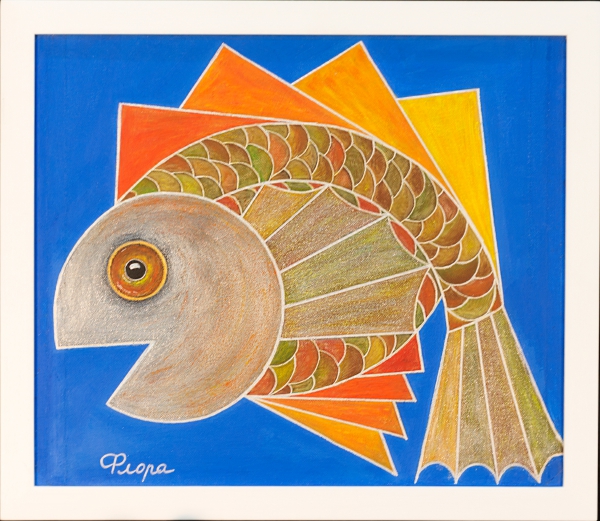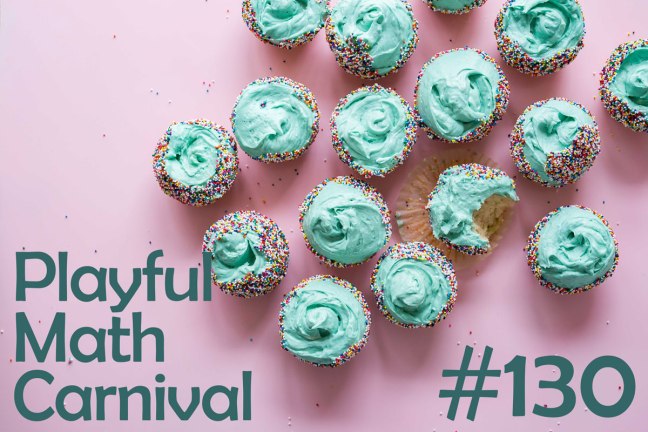Play. Learn. Enjoy!
Welcome to the 130th edition of the Playful Math Education Blog Carnival, a feast of delectable tidbits of mathy fun.
The Playful Math Carnival is like a free online magazine devoted to learning, teaching, and playing around with math. It’s back-to-school time in the U.S., so this month’s edition focuses on establishing a creative math mindset from preschool to high school.
You’re sure to find something that will delight both you and your child.
By tradition, we start the carnival with a puzzle in honor of our 130th edition. But if you would like to jump straight to our featured blog posts, use our handy Table of Contents.
Contents
 Some blog articles were submitted by their authors, others were drawn from the immense backlog in my rss reader, and the beautiful illustrations are from the 2019 Bridges Conference Mathematical Art Gallery.
Some blog articles were submitted by their authors, others were drawn from the immense backlog in my rss reader, and the beautiful illustrations are from the 2019 Bridges Conference Mathematical Art Gallery.
If you’d like to skip directly to your area of interest, click one of these links:
- Puzzle: Cake Numbers
- Talking Math with Kids
- Exploring Elementary Arithmetic
- Adventuring into Algebra and Geometry
- Scaling the Slopes of High School Math
- Enjoying Recreational Puzzles and Math Art
- Teaching with Wisdom and Grace
- Giving Credit Where It’s Due
Would you like to see YOUR favorite blog post in next month’s Playful Math blog carnival? Submissions are always open.
We need more volunteers: Classroom teachers, homeschoolers, unschoolers, or anyone who likes to play around with math (even if the only person you “teach” is yourself) — if you would like to take a turn hosting the Playful Math Education Blog Carnival, please speak up!
Puzzle: Cake Numbers
 Visual math promotes understanding. When children learn to see numbers, shapes, and relationships with their minds’ eye, they find new concepts easier to grasp.
Visual math promotes understanding. When children learn to see numbers, shapes, and relationships with their minds’ eye, they find new concepts easier to grasp.
The puzzle of cake numbers will stretch your students’ visualization skills. In math, a cake number is the maximum number of pieces we can cut a 3-dimensional cake into, using a planar (infinitely long, straight) knife.
Today’s carnival number 130 is a cake number.
Can you visualize how many cuts it would take to make 130 pieces of cake?
Start with a simpler puzzle to give your mental muscles a workout. Try a hands-on experiment with cake numbers:
- Get a large block of cheese and a sharp knife.
- See how many different pieces you can cut.
- With zero cuts, of course, you get one piece — the whole cake.
- With one cut, you get two pieces.
- How many pieces can you get with two cuts? With three?
Here is a picture of four planes cutting through space. Can you count the pieces of cake?

Don’t get fooled! The first few cake numbers make the pattern look simple. But the fourth cut will not make 16 pieces.
For a simpler 2-dimensional puzzle, try cutting a flat pancake or pizza. Read more about pizza-cutting in Playful Math Carnival #106.
And if you’re still wondering, it takes nine cuts to make 130 pieces of cake.
[Back to top.]
[Back to Table of Contents.]
Talking Math with Kids
- Kent Haines (@KentHaines) always has great suggestions to get kids talking about math. For example, try his Garbage – A Perfect Pre-School Card Game.
- Paula Beardell Krieg (@PaulaKrieg) raises Kent’s game to a new level of hands-on creativity in Making Game Cards with Kindergarteners.
- Scientific exploration led to many advances in mathematics. So be sure to talk science with your kids, too! Erika (@PlayfulScholar) shares 3 Science Based Play Ideas to Keep Toddlers Engaged.
- “What If?” is a key question in math and science. Bethany Lake (@mathgeekmama) offers a free printable Creative Math Writing Prompt: The Day the __ Quit! to get kids thinking and talking about math.
- Jenna Laib (@jennalaib) says, “I love, love listening to early understandings of an idea: students worm their way through a concept, pushing forward and circling back, and looking up with furrowed eyebrows. It’s a time of electric vulnerability.” Check out her post Listening to Early Understandings of Division: “12 ÷ 5 is either -3 or 0”.

[Back to top.]
[Back to Table of Contents.]
Exploring Elementary Arithmetic
- Want to strengthen your children’s mathematical understanding? Steve Wyborney (@SteveWyborney) provides a powerful series of ready-to-use puzzles in 20 Days of Number Sense & Rich Math Talk (K-12).
- Counting is harder than you thought — especially when you try to learn a different language! Paul Smith explains in the Numberphile (@numberphile) video Problems with French Numbers.
- Speaking of counting, Sarah Carter (@mathequalslove) shares a cool counting puzzle copied from the old Stella’s Stunners problem-solving site.
- Have you signed up yet to Get Your Weekly KenKen Puzzles for Kids? It’s a fun way to practice math skills and logical thinking.
- Counting rabbits can promote math skills, too — just ask Fibonacci. Kow-Cheong Yan (@MathPlus) looks at all the different ways to play with Rabbit Math.
- Sunil Singh (@Mathgarden) tells why My Daughter Got a D- in Fractions: Neither One of Us Care. You may also enjoy his article Math Education’s Moral Compass is Broken and Only Play Can Fix It.

[Back to top.]
[Back to Table of Contents.]
Adventuring into Algebra and Geometry
- Amie Albrecht (@nomad_penguin) offers two of my favorite Activities for Day One: Fold-and-cut, Quarter the Cross.
- Erik Nauman (@openblackboard) hosts a free online Shape Tiler program where kids (and adults!) can explore tessellations and create math art using shapes, intersections, and symmetry. To play offline, download the ShapeTiler App.
- Do you teach the quadratic formula? Now you can blow your students’ minds with The Citardauq Formula from James Tanton (@jamestanton).
- Craig Barton (@mrbartonmaths) shared it as an end-of-year algebra review, but I think the Factorisation murder mystery makes a fun kick-off puzzle for geometry or algebra 2 students.
- Simon Gregg (@Simon_Gregg) plays with geometric tilings and finds surprising discoveries in the return of the dodecagon. You may also enjoy his earlier dodecagon posts.

[Back to top.]
[Back to Table of Contents.]
Scaling the Slopes of High School Math
- Mike Lawler (@mikeandallie) tackles some big math ideas through conversations with his sons. Watch Using Brian Skinner’s terrific math joke for a lesson about logarithms. I also enjoyed Sharing Numberphile’s “Amazing Graphs” video with kids.
- Sue VanHattum (@suevanhattum) wants to prompt student curiousity with a hands-on review activity on the first day of class. Here are her ideas for geometry, precalculus, and more.
- Melissa Copland (@mpcopland) poses a wonderful Break the Calculator puzzle for her students.
- What math topics confuse your students? Or which ones stump you? Joseph Nebus (@nebusj) asks for topic suggestions to fill his Fall 2019 Mathematics A-To-Z. (Take time to explore some past topics at the bottom of the post.)
- By the time they reach high school, most students believe that math is boring. Introduce your students to the “World’s Most Interesting Mathematicians” who share their favorite bits of mind-blowing math in The Big Internet Math-Off 2019.
- And don’t miss the 172nd Carnival of Mathematics.

[Back to top.]
[Back to Table of Contents.]
Enjoying Recreational Puzzles and Math Art
- Puzzles are a fantastic way to build a playful attitude towards math. Ellie posts this fun Math Class First Day Activity, with a free printable from her TPT store.
- Skyscraper puzzles are one of my recreational-math favorites. Mark Chubb (@MarkChubb3) makes them hands-on with Skyscraper Templates for (1 cm) Relational Rods. Or if you’d rather use 3/4-inch linking blocks, download his original Skyscraper Templates.
- Druin (@druinok) collects a variety of puzzles in a binder, setting out new ones each week for students to wander by and get hooked. And I love her cute M-A-T-H door!
- When I asked for first-day math ideas on Twitter, Benjamin Leis (@benjamin_leis) suggested these Tetris Picross Puzzles.
- For my entry to the carnival: Math Art! I share my free printable Geometric Coloring Designs booklet, with new links to online resources, including Islamic Geometric Design patterns. You may also enjoy the article Using Islamic Geometry for Student Buy-In.
- Number theory is a rich source of playful math puzzles. Iva Sallay (@findthefactors) explores An Efficient Way to Quickly Find All the Odd Prime Numbers Less Than 1369. You may also enjoy Powers of 2 in the (Giant) Multiplication Table.

[Back to top.]
[Back to Table of Contents.]
Teaching with Wisdom and Grace
- Howie Hua (@howie_hua) offers three First Day of School discussion prompts to kick off math discussions with your kids.
- Sara VanDerWerf (@saravdwerf) helps students understand productive group dynamics with her modern classic ice-breaker puzzle 100 Numbers to Get Students Talking.
- Need more ice-breakers? Sarah Carter (@mathequalslove) collects an overwhelming 21 Ideas for the First Week of School. Your students may also enjoy her Math Joke of the Week Posters.
- Sam Shah (@samjshah) asks, “How do you highlight that the doing of mathematics is a human endeavor?” Follow the amazing discussion at his Virtual Conference on Humanizing Mathematics.
- JoAnne Growney (@MathyPoems) suggests we Enrich Mathematics Classes with Poems. You may also enjoy Mathematicians are not just white dudes (and all her other posts).
- We want our kids to think deeply about mathematics. But what about ourselves? NCTM (@NCTM) President Robert Berry encourages teachers to Start the School Year by Unpacking Your Why.
- Has a new belief, behavior, habit, or tool improved your teaching this year? Anthony Persico (@mashupmath) shares several thought-provoking tips in What Math Teaching Strategies Work Best? 16 Math Education Experts Share Their Suggestions.

[Back to top.]
[Back to Table of Contents.]
Giving Credit Where It’s Due
“Teal cupcakes” photo (top) by Brooke Lark, “Five cupcakes” by Rae Goldman, and “Colorful layer cake” by Annie Spratt via Unsplash.
Art images are from the 2019 Bridges Conference mathematical art gallery.
And that rounds up this edition of the Playful Math Education Blog Carnival. I hope you enjoyed the ride.
The next installment of our carnival will open sometime during the week of September 23–27 at Find the Factors blog. If you would like to contribute, please use this handy submission form. Posts must be relevant to students or teachers of preK-12 mathematics. Older posts are welcome, as long as they haven’t been published in recent editions of this carnival.
Past posts and future hosts can be found on our blog carnival information page.
